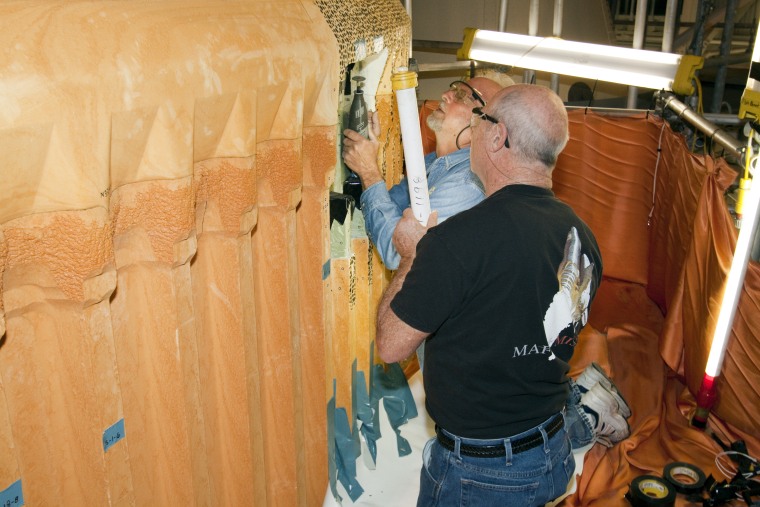The space shuttle Discovery will have to pass up an opportunity in early February for its final launch, due to continuing repairs to its external fuel tank, a NASA spokesman said Thursday.
That was the main message coming out of a management meeting headed up by shuttle program director John Shannon, according to Kyle Herring, a spokesman at NASA's Johnson Space Center.
"The Feb. 3 to 10 window is pretty much off the table," Herring told msnbc.com.
Managers deferred setting a new launch date for another week while tests continue to assess how much repair work should be done. Currently, engineers have the go-ahead to make modifications to 34 of the 108 support ribs, or "stringers," on Discovery's tank.
Discovery was originally scheduled to lift off on a resupply mission to the International Space Station on Nov. 5, but the launch was postponed because of a hydrogen fuel leak. During later inspections, cracks were found in some of the stringers. The shuttle eventually had to be brought off the launch pad to the Vehicle Assembly Building at NASA's Kennedy Space Center in Florida for more thoroughgoing inspections and repairs.
NASA wants to minimize the risk that pieces of insulating foam could fly off from the tank during ascent and damage the shuttle's protective skin. Such a scenario is thought to have led to the catastrophic breakup of the shuttle Columbia during re-entry almost eight years ago, killing all seven astronauts aboard. The Columbia tragedy was a key factor behind NASA's decision to retire the shuttle fleet.
Engineers have not yet determined the root cause behind the tank's cracked ribs. They're continuing to assess whether all of the tank's 21-foot-long (6.4-meter-long) ribs should be uncovered and reinforced, Herring said. A decision on that step is to be made on Monday.
"You want to make sure you do no harm, No. 1," Herring said. "And No. 2, that you're incorporating a modification that will make the tank structurally sound and ready to fly."
In any case, it was clear that the launch team could not be ready in time for the Feb. 3-10 launch opportunity, Herring said. The next opportunity opens up in the Feb. 24-27 time frame, depending on how NASA and its partners manage the logistics for getting to the space station.
During Discovery's mission, designated STS-133, astronauts are due to deliver tons of supplies and equipment, including a humanoid robot named Robonaut 2 and an Italian-built module that will be used as a storage room on the station.
Discovery is to be retired after STS-133. Shifts in Discovery's launch would likely affect the schedule for the two station-bound flights that would follow: Endeavour's mission to deliver the Alpha Magnetic Spectrometer in April, and Atlantis' resupply flight in June.
Atlantis' mission is expected to mark the final flight of the 30-year-old space shuttle program. After the fleet's retirement, NASA plans to resupply the space station using transport vehicles provided by other nations and U.S. commercial ventures.
